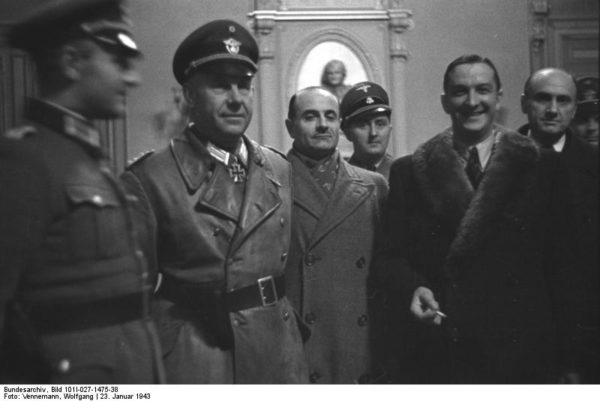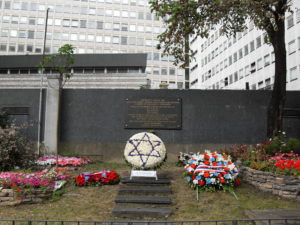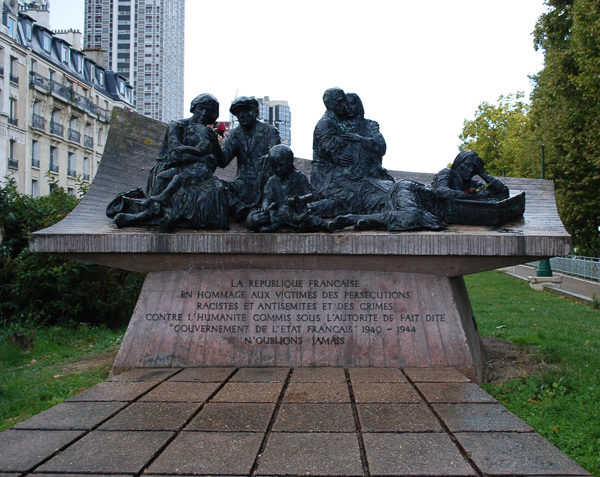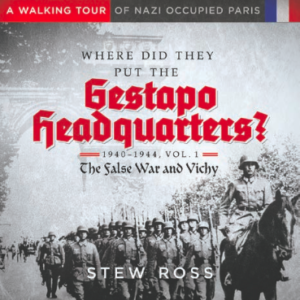It began on 14 June 1940 when the Germans marched into Paris to start their four-year occupation of the city. Initially, the Occupation was rather benign. Soldiers were ordered to be on their best behavior with the locals. For the most part, Paris citizens did not experience large changes in their daily routines other than the presence of the occupier.
Then it all began to change.
By 1942, the most dreaded sound was a knock on the door in the evening (click here to read the blog Night and Fog). Chances are it was either the French police or Gestapo agents. They were there for one reason: to make arrests. The apartment occupants could have been Jewish, suspected Resistance members or their families, black market participants, criminals, or known undesirables (e.g., Communists, Roma, Polish, Masons, or other Eastern Europeans).
Rafle du Vélodrome d’Hiver or Rafle du Vél’ d’Hiv
“The Vél’ d’Hiv Roundup”
On 16 July 1942, the knock came to the apartment door of Rabbi Bereck Kofman and his family. The rabbi of the small synagogue located on the Rue Duc was arrested by a French policeman. The entire family (his wife and six small children) accompanied Rabbi Kofman to the police station. They never saw him again. His daughter, Sarah Kofman, became a noted French philosopher and writer. She wrote about her wartime experiences during the occupation in her moving book Rue Ordener, Rue Labat. Shortly after writing the book, Ms. Kofman committed suicide.

Over the next 48-hours, French police rounded up more than 13,000 French Jews in what was the greatest mass arrest on French soil. Approximately 71% of the arrested persons were women and children (more than 4,000 children were arrested—the youngest deportee was 18-months old). More than half of the arrestees were taken to the Vélodrome d’Hiver (Winter Velodrome). After being “sorted,” they were taken to detention camps such as Drancy (northern suburb of Paris) before boarding the cattle cars to the extermination camp known as Auschwitz.
For those of you who are familiar with the book or have seen the movie Sarah’s Key (2010), you will remember that the Vélodrome d’Hiver played a significant role in this story about the July Vel’ d’Hiv roundup.
Planning The Roundup
While it was the French police who executed the plans for the Roundup, the Germans devised the plan. After the war, evidence was uncovered that the head of the French police, René Bousquet (1909–1993: assassinated), actually tried to increase the arrest quotas and ordered the arrest of children under the age of 16 (German orders were not to arrest children under 16 or pregnant women). The Vichy government and its prime minister, Pierre Laval (1883–1945: executed), had been intimately involved in the planning.
On 4 July 1942, Bousquet and Louis Darquier de Pellepoix (1897–1980: old age) arrived at Gestapo headquarters in Paris to meet with Theodor Dannecker (1913–1945: suicide) and Helmut Knochen (1909–1993: old age). De Pellepoix was the French commissioner of the General Commission to Jewish Affairs. Dannecker was the SS captain responsible for German police in France while Knochen was an SS officer involved in the planning of Jewish roundups (he was also responsible for the arrest and executions of SOE agents—click here to read Women Agents of the SOE).
A follow-up meeting was held on 7 July when other French government representatives joined in: Bousquet’s deputy, Jean Leguay, Jean François, director of the general police, Émile Hennequin, head of the Paris police, and André Tulard, assistant director of the Bureau of Aliens and Jewish Affairs.
By 10 July, the plans had progressed to the point where Dannecker presented them to Adolf Eichmann at Gestapo headquarters on Avenue Foch. Included in the planning stage by now were representatives of the French railway service, the SNCF.
The Velodrome
The original Velodrome was an indoor arena built in the late 19th-century for the Paris World’s Fair, which ended in 1900 (it was actually called the Salle des Machines). It was moved in 1909 to a nearby location on the corner of Boulevard de Grenelle and Rue Nélaton and renamed the Vélodrome d’Hiver.
The arena was built primarily for cycling races but also used for ice hockey, wrestling, boxing, roller skating, and other public events (the Velodrome was used for the 1924 Olympics when it hosted the boxing, fencing, weightlifting, and wrestling events). Ernest Hemingway was a frequent visitor to the Velodrome when he lived in Paris during the 1920s.
During the roundup, more than 13,000 people were held in the Velodrome. It had a dark glass roof which increased the inside temperature. The Germans ordered all of the lavatories to be either blocked or sealed. The only food and water for the detainees came from the Quakers and the Red Cross. Only a handful of doctors and nurses were allowed access. The people were held in the Velodrome for five days. Families were herded into the Velodrome before taken to Drancy or directly to the railroad cars.

Only 400 survived and returned to Paris after liberation from the camps. Of the more than 13,000 arrested in the roundup, only a few children came back in the group of survivors.

The Vélodrome d’Hiver was destroyed by fire in 1959. A plaque memorializing the Roundup had been placed on the old building. After the fire, it was moved to 8, boulevard de Grenelle. A statue/monument was erected in 1993. Its curved base represents the cycle track. The persons represent deportees including children, pregnant women, and a sick man.
The monument’s inscription reads “The French Republic in homage to victims of racist and anti-Semitic persecutions and of crimes against humanity committed under the authority of the so-called ‘Government of the State of France.’ “
Rabbi Kofman
Rabbi Kofman was taken to Auschwitz where he was murdered by a Jewish butcher who was one of the camp’s Kapos. A pickax was used by the Kapo when Rabbi Kofman refused to work on the Sabbath. He was reportedly buried alive. At the end of the war, the Kapo returned to Paris and reopened his butcher shop on Rue des Rosiers.
The Apology
One of the disturbing facts I have been left with during my research has been how so many of these criminals got off after the war without being held accountable for their actions. Not one of the men responsible for the planning and execution of the Rafle du Vél’ d’Hiv were ever tried for these specific crimes against humanity. The one person directly responsible, René Bousquet, was an old Vichy friend of the French president, François Mitterand. Bousquet finally was held accountable and his trial was scheduled in 1993. However, he was assassinated before the trial began.
The common thread was that the Allies (Charles de Gaulle in particular) pardoned a lot of them after only serving minimal prison times. I’ll discuss the reasons for this in the new book.
However, there is one fact—the French government never apologized for its role during the Occupation. It never accepted responsibility for the police actions, the collaboration with the Germans, and its role in the deportations to the extermination camps of more than 75,000 Jews.
On 17 July 1994, Mitterand’s successor, President Jacques Chirac stood in front of the memorial statue dedicated to the memory of the victims and declared that France was guilty of collaborating with the Germans and the complicity of the French police in the roundups.
NEWEST BOOK: WHERE DID THEY PUT THE GESTAPO HEADQUARTERS? A WALKING TOUR OF NAZI OCCUPIED PARIS (1940–1944)
Today’s blog describes several locations where I will take you in my next book. Over the foreseeable future, I will devote some of the blogs to sites that were significant during the Occupation of Paris. I hope you enjoy the abbreviated stories and perhaps they may spark an interest in my new book (coming soon).
Someone Is Commenting On Our Blogs
Thank you to our very good friend here in SW Florida, Joanie S., for commenting on how she enjoys reading the blogs. She specifically commented on how she enjoyed the writing style. Not being a trained writer (thank goodness for my editors), I was especially grateful.
If there is a topic you’d like to see a blog written about, please don’t hesitate to contact me. I love hearing from you so keep those comments coming.
We need your help
Please tell your friends about our blog site and encourage them to visit and subscribe. Sandy and I are trying to increase our audience and we need your help through your friends and social media followers.
Thank You
Sandy and I appreciate you visiting with us. We have some exciting things on the horizon and we’ll keep you updated as we go along.
What’s New With Sandy and Stew?
Once a year, the French government opens up certain government offices for people to visit. These buildings have historical significance. Well, this year that day falls on Saturday 17 September 2016. Our friend in Paris, Raphaelle Crevet, will be visiting several of these and taking pictures for us. If you’ve followed my blogs over the years (or read the books), you should be familiar with Raphaelle. She is the only one we turn to when in Paris for our personalized tours.
Share This:
Follow Stew:
Find Stew’s books on Amazon and iBooks.
Please note that we do not and will not take compensation from individuals or companies mentioned or promoted in the blogs.
Walks Through History
Copyright © 2016 Stew Ross



I am glad you all had a good time on your holidays and I agree with you the prices in London are a disgrace and I find I sad I have not been to any of the sights you have been to maybe some time I will visit them .
The Round Up was disgraceful and I wonder how many French Men disappeared especially policemen the more I see films like this the more it turns my stomach
I also have read how many new resistance men turned up as the war was it end hundreds even more .I wonder how many French men and woman had relatives who where in the milice we never hear about them I would love to know if there is any books that I could read .I myself have read over two thousand books maybe more over the last forty years
Hi David; Yes, it was disgraceful and to think that after the war, the French police were given resistance rewards. There are thousands and thousands of stories we will never know as the participants have taken them to their graves. STEW
Yes I agree with you Stew the amount of criminals who got away with literally murder stinks that’s why I say how many French people must know there past history and say nothing.
David, I know the French are aware of the role the police and Vichy played during the Occupation. But like many unpleasant memories, those events tend to be suppressed. It is always better to discuss what happened so as to hopefully, help prevent future occurrences. STEW